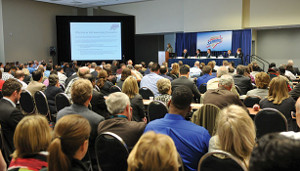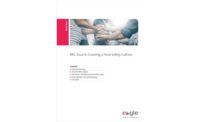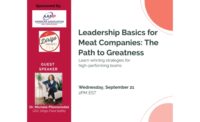 Customer and consumer trust is not a traded commodity on the open market. We know this trust is earned over time. Food safety is one of the components of this trust-building process, and although it alone cannot build trust in a brand or company, it certainly can affect or destroy that trust.
Customer and consumer trust is not a traded commodity on the open market. We know this trust is earned over time. Food safety is one of the components of this trust-building process, and although it alone cannot build trust in a brand or company, it certainly can affect or destroy that trust.
Companies that successfully deploy a preventive mindset are more likely to avoid food-safety events or situations that can cause one to question product safety. Food-safety practices that have their foundation in preventive measures are more likely to be effective than those that are regularly garnished with a dose of firefighting by company management.
The late Paul Van Eekeren, entrepreneurial leader of Land O’ Frost for more than 30 years, once said, “How we get there is as important as our mission itself.” We have since learned in those 30-plus years that “trust” awaits at the end of that journey.
Our industry is faced with “Meatless Mondays,” biased social media with a desire (and even a mission) to destroy the basis of our business existence, and a growing public expectation of food safety that minimizes their personal responsibility. Our food-safety systems and processes must recognize these threats while building and maintaining a high level of trust with our customers and consumers.
A company’s HACCP program is a fundamental part of its food-safety system. Unfortunately, HACCP is not designed to directly control or prevent all potential food-safety incidents — many are not directly controllable by a critical control point. Prerequisite programs are designed to address those hazards. Many food processors have had some form of HACCP in place to cover 20 years. That experience has taught us that HACCP and prerequisite programs alone do not always prevent the occurrence of these difficult-to-control hazards.
Hazards that are managed by the use of constant or continual corrective action stress the customer and consumer trust-building process. Actions taken or “best practices” to prevent, rather than continually manage, chronic problems are recognized as the preferred method to reduce risk. (For more on this concept, see “Don’t simply alter GMPs; attack Listeria at the source” on page FSR-18.) These preventive practices are being recognized in the regulatory process as well as regulatory risk assessments.
As we look beyond our USDA-FSIS regulations, we observe the new FDA Food Safety Modernization Act (FSMA) proposed rule to use the phrase “preventative practices.” This document encourages FDA establishments to recognize those control measures that are preventive in nature.
Food safety is part of the foundation on which our companies are built. Our role in food-safety management is to continuously build from that foundation a system that secures our company’s future against the various risks and threats associated with a food-safety incident.
The meat industry has built trust with our shared consumers by making significant investments in money, time and labor to build strong food-safety systems. This investment includes the sharing of best practices between fiercely competitive companies. Conducting and publishing research that provides a scientific basis for predictable control, as well as working together to define guidelines for sanitary design in both our facilities and equipment, has become commonplace. I have yet to hear one meat company CEO state that they had made foolish or unnecessary food-safety investments.
A preventive practice is one that is out in front of an event that could compromise our product. Effective pasteurization of maintenance and operator tools is an example: It prevents these tools from becoming harborage sites that could lead to product contamination.
This preventive practice requires capable measurements. For instance, the pasteurization treatment of operator tools in hot water can either be a lethal process or a growth stimulant. Time and temperature determine the fate.
Likewise, one of the most significant critical factors in Listeria control is the clear and concise operative definition of the level of disassembly for a complex machine during the cleaning and sanitation process. These are two very simple examples of preventive procedures that can make a difference whether a harborage location will result in an outbreak or can be controlled as a business risk.
We depend on a variety of prerequisite programs to minimize risk by exerting a level of control over processes that have no absolute control method, such as pathogen contamination of an exposed product. The inherent variation of an incapable or unmeasured method for food-safety process control may be the difference between building or violating consumer/customer trust.
Incapable process-control measurement systems, practices and procedures result in uncontrolled risk. Special causes in this situation can magnify the risk. This incapability can and should be viewed by management as a process-control system that is managed by firefighting. When chronic violations occur and the only mitigation is corrective action, risk control may become vulnerable. Coupling corrective action with continuous-improvement preventive actions is the preferred way of attaining the desired level of control. Capable measurement systems are required to assure process control of a prerequisite program. In many situations the measurement systems as well as the process-control method have to be addressed in the scope of the preventive action project work.
Technology will evolve and stronger controls will be developed, all on a continuous basis. Until those technological breakthroughs are developed and commercialized, we must work toward the development of best practices or hurdles that incrementally reduce risk.
As food-safety scientists and professionals, we must learn how to capture and analyze data that drives our companies to the preventive and predictive state, rather than accepting the continuing and ongoing firefighting associated with chronic situations. Awareness of these chronic situations or thoroughness of the risk assessment is the first step. We become enlightened when project activities direct us to a new hurdle or best practice that reduces the risk.
System design and redesign is often needed to hold these gains for the long-term. That is the essence of conversion of corrective-action programs to programs combining corrective action and preventive action (CAPA). Our perception of “Corrective Action” must include “Preventive Action.” The act of holding the gains accomplished with a best practice can be viewed as the attainment of the preventive state.
To evaluate this concept, simply look at the data table or database used to track process failures and corrective actions. Conduct risk analysis of entries. Group the associated common entries with those of the most significant risk. Next, create a project that has the expected results of significantly reducing this risk. Success of this project will result in preventive action.
Food-safety management projects a vision that defines the company’s path in brand and consumer protection. Food-safety management’s role is not done when the corrective action is complete and documented. Scientific-based preventive and predictive practices must next be deployed.
The tools we use often include the development of new management processes and systems. In food-safety management, we are not measured by the corrective actions that we continuously deploy. We are measured by the preventive and predictive practices we develop and implement.
Food-safety management is one of the guardians of trust in a meat-processing company. Is “trust building” part of your job description?




Report Abusive Comment